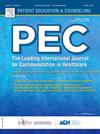提供系统性红斑狼疮患者人乳头瘤病毒感染信息的消费者网站的内容和质量:环境扫描。
IF 2.9
2区 医学
Q2 PUBLIC, ENVIRONMENTAL & OCCUPATIONAL HEALTH
引用次数: 0
摘要
目的:我们旨在评估为消费者提供系统性红斑狼疮(SLE)患者人乳头瘤病毒(HPV)风险信息的网站的内容和质量。方法:我们对患者和公众网站进行了环境扫描,了解HPV和SLE的信息。我们搜索谷歌从成立到2023年6月,使用术语“HPV”和“狼疮”。我们纳入了有关HPV和SLE信息的网站。两名评审员对网站进行评价,收集网站特征,并对网站的完整性和全面性、准确性、技术元素、设计和美学、可用性、可读性和可访问性等属性进行评分。结果:我们确定了16个网站进行分析。10个(62.5 %)是商业网站,其中一个网站提供了完整和全面的关于SLE患者HPV风险、筛查和疫苗接种的信息;7个(44% %)网站只提供有关HPV疫苗的信息。8个网站包括了SLE患者的HPV感染风险、宫颈癌筛查和宫颈癌风险。75%的人根据临床指南、教科书、同行评议的论文或科学出版物提供信息,其余的人则基于专家意见。所有的网站都被认为具有足够的设计和美学,并且易于浏览。只有1个(6 %)网站的阅读水平为6年级,其他网站的阅读水平高于6年级(不适合消费者网站)。总体质量得分从32分到51分(最高69分)。结论:我们的研究结果表明,大多数为患者和公众提供HPV和SLE信息的网站并没有提供完整和全面的HPV信息。本文章由计算机程序翻译,如有差异,请以英文原文为准。
Content and quality of consumer websites providing information about human papillomavirus infection in patients with systemic lupus erythematosus: An environmental scan
Objective
We aimed to evaluate the content and quality of websites for consumers providing information about human papillomavirus (HPV) risks in patients with systemic lupus erythematosus (SLE).
Methods
We conducted an environmental scan of websites for patients and the general public with information about HPV and SLE. We searched Google from inception to June 2023, using the terms “HPV” and “lupus”. We included websites with information about HPV and SLE. Two reviewers appraised the websites and collected website characteristics, and rated various attributes: completeness and comprehensiveness, accuracy, technical elements, design and aesthetics, usability, readability, and accessibility.
Results
We identified 16 websites for analysis. Ten (62.5 %) were commercial websites One website provided complete and comprehensive information about HPV risk, screening, and vaccination in patients with SLE; 7 (44 %) websites provided only information about the HPV vaccine. Eight websites included risk of HPV infection, cervical cancer screening, and cervical cancer risk in patients with SLE. Seventy-five percent provided information based on clinical guidelines, textbooks, peer-reviewed papers or scientific publications while the remaining were based on expert opinions. All websites were considered to have adequate design and aesthetics and were easy to navigate. Only 1 (6 %) website had a 6th-grade reading level and the other had reading levels higher than that (not appropriate for consumer websites). The overall quality scores ranged from 32 to 51 (maximum 69).
Conclusion
Our findings showed that most websites for patients and the general public with information about HPV and SLE did not provide complete and comprehensive information about HPV.
求助全文
通过发布文献求助,成功后即可免费获取论文全文。
去求助
来源期刊

Patient Education and Counseling
医学-公共卫生、环境卫生与职业卫生
CiteScore
5.60
自引率
11.40%
发文量
384
审稿时长
46 days
期刊介绍:
Patient Education and Counseling is an interdisciplinary, international journal for patient education and health promotion researchers, managers and clinicians. The journal seeks to explore and elucidate the educational, counseling and communication models in health care. Its aim is to provide a forum for fundamental as well as applied research, and to promote the study of organizational issues involved with the delivery of patient education, counseling, health promotion services and training models in improving communication between providers and patients.
 求助内容:
求助内容: 应助结果提醒方式:
应助结果提醒方式:


